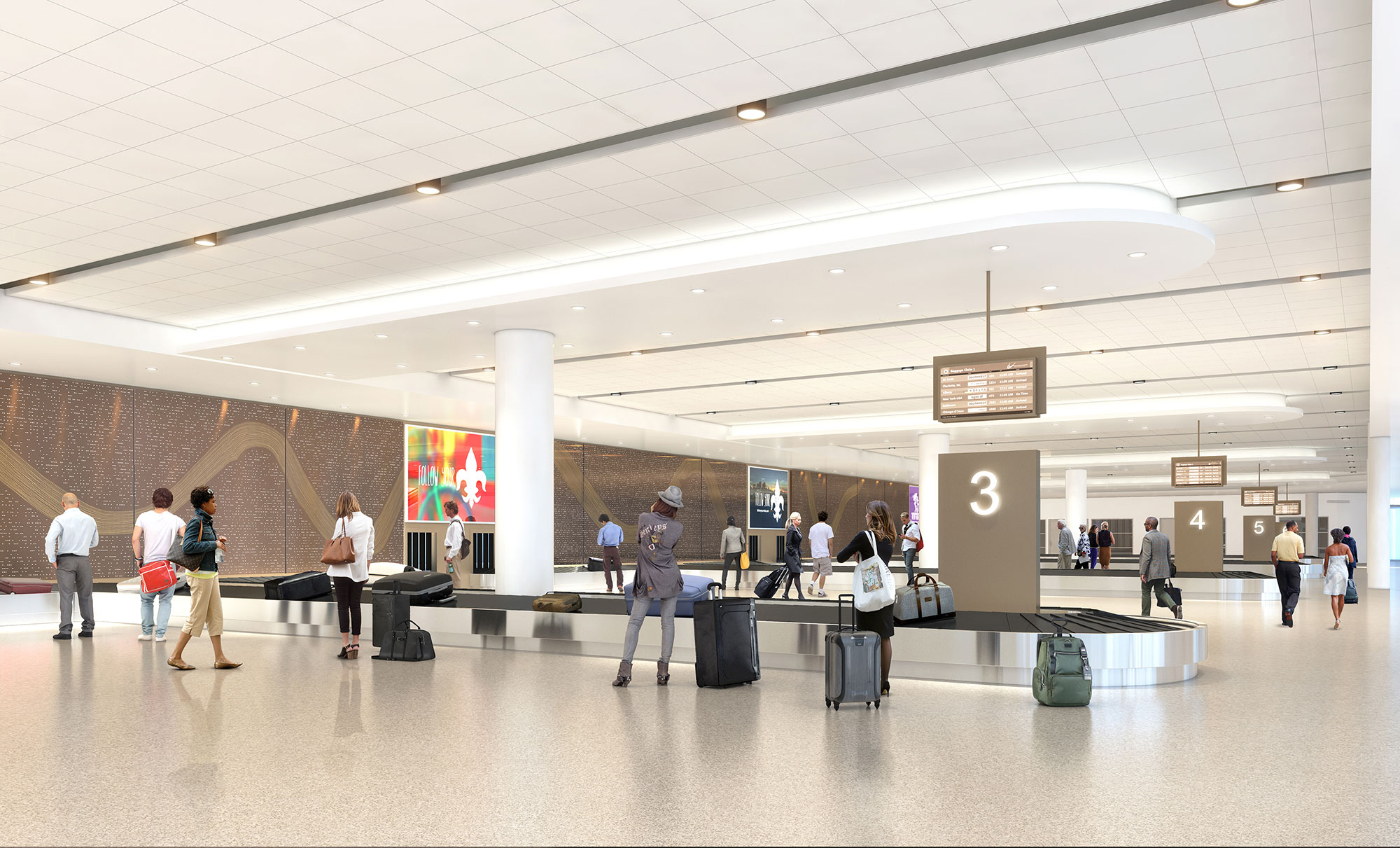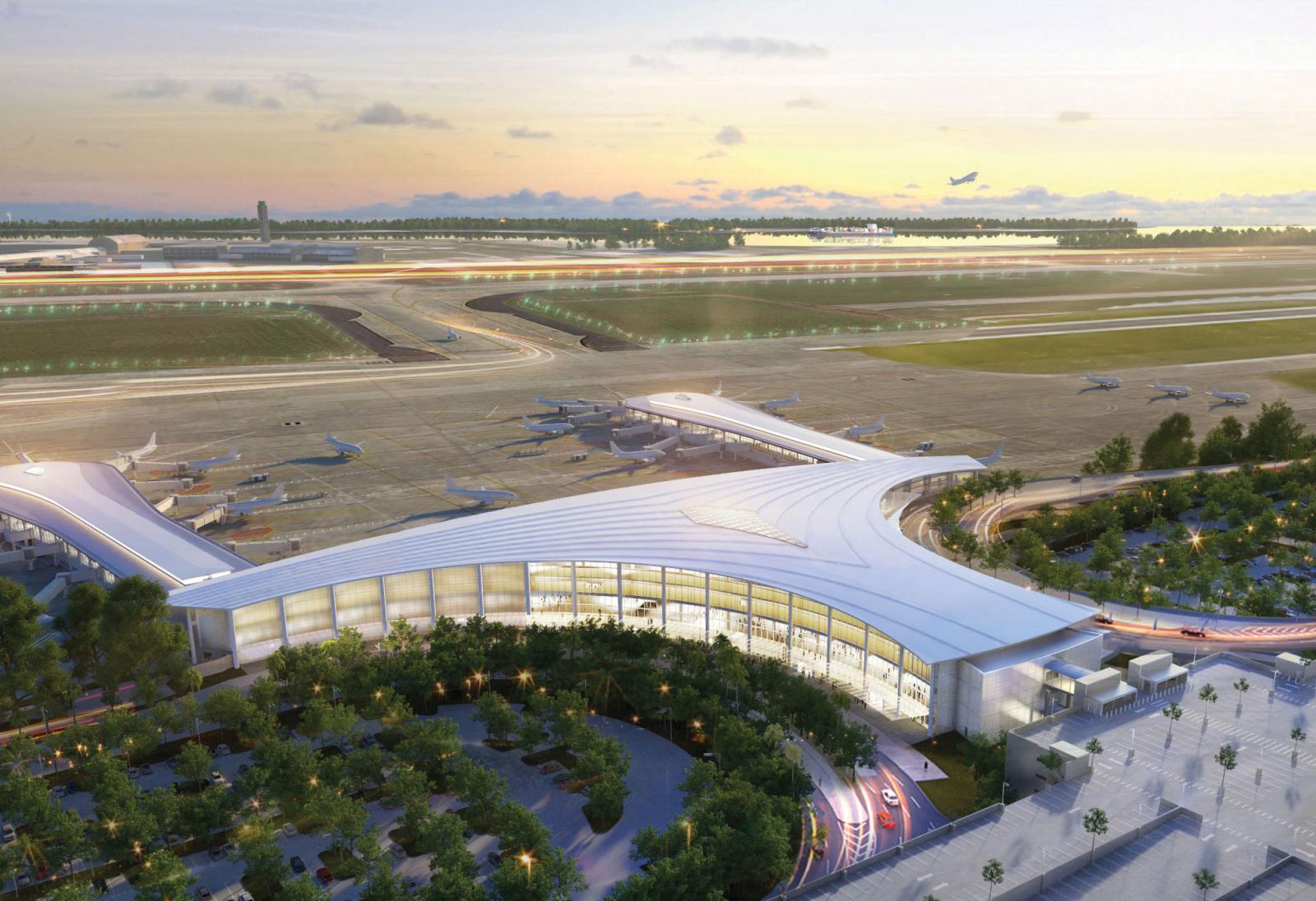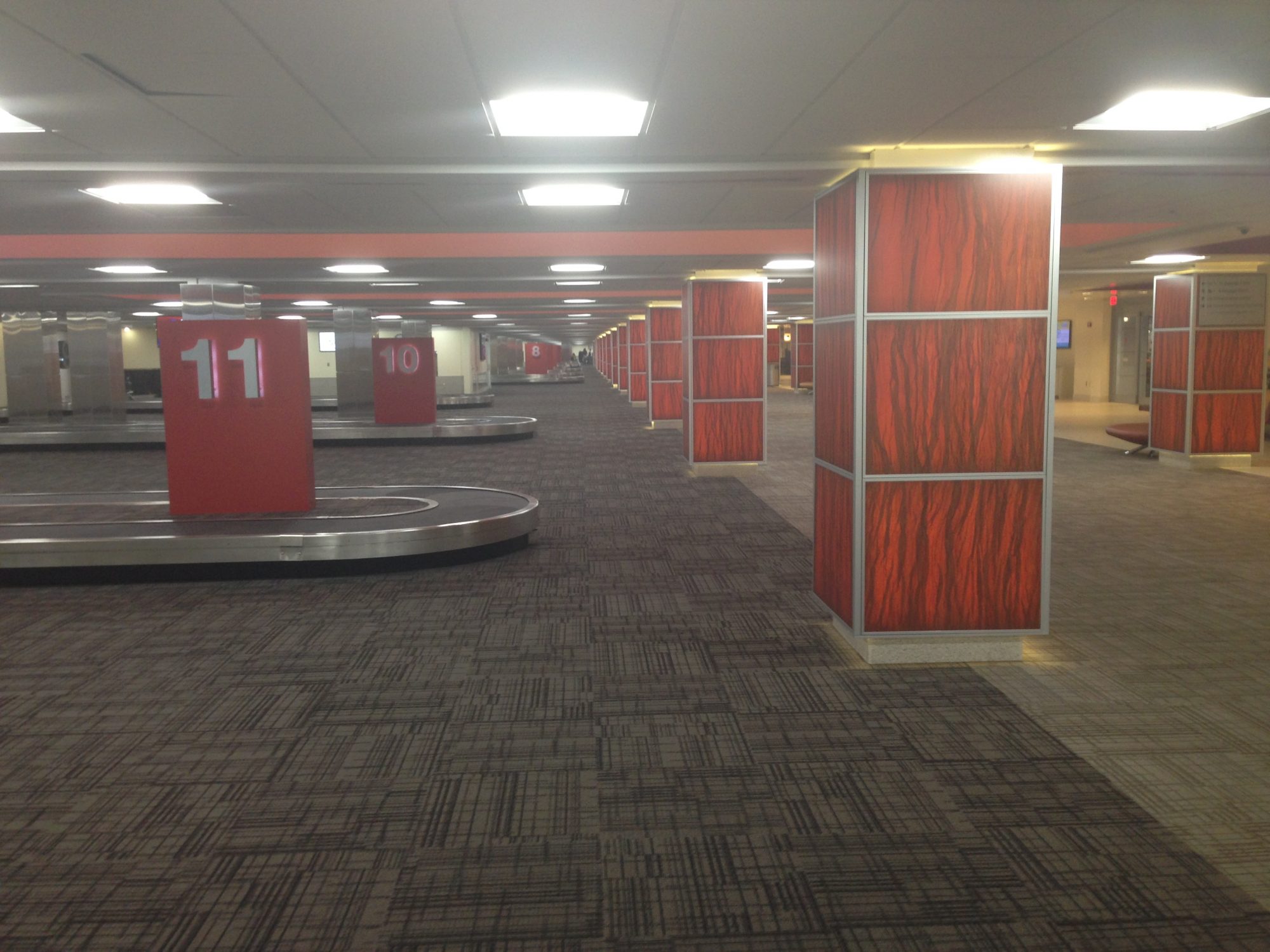This terminal’s days are numbered, though not many who pass through my home airport realize it (a sentence from the Anthropocene if there ever was one). But in just five months, Louis Armstrong International airport will be abandoned overnight. These plans have been underway since 2011, when a new “world class” airport to serve New Orleans was first announced, one of the many post-Katrina developments aimed to rejuvenate the city. Construction commenced in 2013 and a glassy new structure already gleams across the runway, nearly complete; after the last flights on May 15 and after final passengers leave the old baggage claim, the old airport will be shuttered.
The next morning the terminal and gates will all be new, or at least newly located on the other side of the runways from the old terminal and gates. But the airport is not planning for major growth; at most, its aesthetic appeal is being refurbished, with some calculated adjustments for incremental expansion. In any case, the thinness of the strip of reclaimed ground for the airport—surrounded by wetlands—limits the amount of runway space, more or less, to what is already there. And so, critics of the new airport see a cynical maneuver to lure more tourist dollars to the Crescent City without doing anything significant (like incorporating an affordable light-rail system to downtown or integrating the new airport with real urban development). Another line of criticism has to do with the fragile ecosystem around the airport, and its inescapable proximity to tropical storms; the new airport will be world class, but not ready for the end of the world.
In the meantime, the old airport bustles and flows.
When I headed there in an Uber, recently, my driver’s iPhone kept trying to direct us to the new terminal; still many months from opening, the approach roads were not even finished. But according to whatever geospatial information the phone was accessing, the airport had already moved. This had started happening a couple weeks earlier, my driver said, brushing it off. But there was something unnerving about the persistent command from phone (“Proceed to the route. Proceed to the route.”) as we made our way toward the familiar terminal, where the usual airliners prepared for their usual takeoff, indifferent to the new infrastructure growing up out of the nearby swamp.
The plan is for what is called a “turn-key transition”: on the 15th, passengers will fly in and out of the current airport and the next morning, all flights will be based out of the new terminal. This complete and total changeover will require months of rehearsal and preparation to be successful. A company called Chrysalis has been contracted to facilitate the transition, putting on training and simulations to prepare staff for opening day. The company’s name suggests a romantic, aestheticized transition, as if shedding the old form and emerging as a beautiful new creature.
I find myself lingering on the elaborate nature of this process. For the training and simulations, the airline employees and ground crew will presumably practice moving around dummy aircraft parked at the new gate areas; they will move simulacral luggage to and through the baggage handling zones, even move entire aircraft away from their gates using “push-back” tugs, all, presumably, in obedience to fictional departure times. And even as this is happening, the normal operations they are mirroring will continue on the other side of the runway, a bizarre shadow world of imitation-airport activities in anticipation of the transition to come.
As far as I can tell, the transition will necessitate an almost total duplication of everything that makes an airport what it is: security checkpoints, computerized check-in and boarding systems, informational screens, baggage services, and so much more. Ponder the incredible technological redundancies involved, the phenomenal amounts of abruptly created detritus: hundreds of CPUs, keyboards, monitors, displays, check-in kiosks, information screens, toilets, sinks, seats, light fixtures, conveyor belts; picture all the jet bridges and other infrastructure critical to servicing the actual airplanes, all of it rendered obsolete in an instant. Fully-functioning equipment in the current airport will suddenly cease to be used. Perfectly useful; totally outmoded. Contemplate the eerie existential implications of this soon-to-be ghost space, an abandoned airport, still able to function—as it did the day before—but without any extant purpose.
The difference, of course, is people: before the new terminal is an airport, it’s nothing but a baroque premonition; after the old terminal is shuttered, it is trash.

“Obsolescing materials seem to occupy a strange middle ground,” as Margaret Ronda points out, in her contribution to the book Veer Ecology; the still-working objects in the old New Orleans airport waver in this nondescript realm, caught between the present and the future, basically the same things that will exist in the new terminal—still functional and still functioning—and yet they teeter on the edge of oblivion, tools, utilities, and instruments destined quite soon for the scrapyard, or an unmarked and undisclosed grave at the bottom of the Gulf of Mexico.
The airport recently released a “land use analysis” recommending most of the existing structures be demolished. Part of the old airport will be left intact for potential aviation-related uses or possibly for commercial real estate development. But the report is mainly focused on the land and buildings. The interior objects aren’t even mentioned.
Joanna Walsh recently tweeted a picture from the Birmingham Airport in the U.K., a blurry snapshot of the RyanAir check-in desks with a “Hello” sign above; the angle of her camera lens eclipsed the “o,” so the sign appeared to read “Hell.”
It’s a common sentiment—flying is hell—and grasping for a better version of this experience is like wishing for an even more efficient, more elaborate Hieronymus Bosch scene. But if an airport isn’t an airport without people, I also have the creeping feeling that airports function best without any passengers or flights, with just the routines, the timetables, the fictional schedules and departures and place-holder luggage.
Imagine how many tickets you could sell if people weren’t the size they are? How long the runways could be, if the land wasn’t where it is? (Alexander Payne’s 2017 film Downsizing played with this idea, also with the Anthropocene in mind: miniaturized people can all fly first class.)
“The airport is enhancing its guest experience program to help keep enthusiasm and exceptional standards for care high,” as the MSY’s publicity material promises. But what do these words mean? Since “enthusiasm and exceptional standards for care” are not what travelers associate with commercial flight, we get words like “enhancement,” the promise of transformation and change for the better. But can a state-of-the-art airport really make the drudgery of commercial flight any more pleasant? When airlines haggle for $25 baggage and other add-on fees, and squeeze seating by the half-inch to cut costs? When we can readily admit that an old but still perfectly functioning airport is so much junk, waiting to be relegated to the dustbin of history?

In early December 2018, my son Julien and I took my sister and her son to the airport after their fall trip to New Orleans. We had neglected to get beignets in town during their visit—always too much to do in the Big Easy—so we decided to buy a bunch at the airport, before their flight, and did so at the West Beignets cafe that sits just inside the terminal, before security. After leaving our guests dusted in powdered sugar at the security checkpoint, Julien was parched; so we went looking for a drinking fountain. I was not about to pay premium for a dubiously-sourced bottled water, but as we wandered throughout the old terminal corridors, not a single drinking fountain was to be found.
Eventually, utterly thwarted, I asked an attendant at an information desk where we could find a drinking fountain. At first, he pointed vaguely around a distant corner; “there should be a drinking fountain over there, near the restrooms….” But when I told him we’d just tried there, he looked flummoxed; after leafing through a three-ring binder listing all the airport’s sundry accommodations, he gave up and threw his hands in the air. “I can’t find any,” he said; “But don’t worry, there will be drinking fountains in the new airport!” In the end we found no public drinking fountains pre-security, and so I finally folded and bought an apple juice for Julien.
But it was an odd reassurance, by the volunteer airport ambassador: to quench today’s thirst, the promise of a new terminal. The sentiment obliterated the extant structure, cancelling out any present bungles or missteps. The failures of the moment are rendered nothing when compared to the glorious future to come.
Beyond the delicate geography and precarious climate conditions that put the new terminal at risk, there is another lesson for the Anthropocene here: The wish for a more perfect form of air travel ends up based on a reality that is imperfect if tolerable, at best; and thoroughly implicated in our own demise, at worst. We’ll die of thirst while imagining future flights to paradise.
For now, the old terminal persists, and will continue to work right up until the moment when it will suddenly cease, when the new MSY commences its operations, sparkling and shining with all its clever design and careful planning. Ample drinking fountains and power outlets for all!
It probably will be a nice new airport. But because we’re in New Orleans, because of the city’s fraught history with disasters and recovery, I can’t help but think about a mottled future to come. It might not be immediate. After the new terminal experiences its opening hiccups and snafus—it’s only an airport, after all—the “state-of-the-art” terminal will gradually settle into the usual rhythms and patterns, a “world class” airport which will eventually, imperceptibly become just another part of the world so ambivalently scorned-and-adored by our species. So much energy, so much technology, and so much vision, all harnessed to bring about a dynamic portal for human adventure. So much unacknowledged waste and refuse created in the process—metonymies of the much vaster hellscape that portends our doom, beyond the runways.

Christopher Schaberg






